This page presents the theoretical background that contributed, in the first place, to the design of the study and, subsequently, to the establishment of its objectives, methodology and expected results. For this purpose, a theoretical framework was structured based on previous research carried out by academics in different parts of the world, and which addresses the issues of the project at three levels:
First, they broadly establish the relationship between Design as a discipline and human affectivity. Secondly, they discuss more specifically the relevance for Design of a definition of the expressive qualities of different materials, and thirdly, the determination of these qualities in wood, including its perception, sensations and affective valuations.
This information can also be accessed in the paper (currently only available in Spanish):
Jacob-Dazarola, R.; Venegas, M.; Donoso, S. (2019) “Hacia una caracterización experiencial de la madera como material para el Diseño de Productos.” Legado de Arquitectura y Diseño v. 14, n. 25, p. 62-71, oct. 2019. ISSN 2448-749X. URL: https://legadodearquitecturaydiseno.uaemex.mx/article/view/12033
In order to fully understand this project, it is important to know previously some theoretical aspects regarding the discipline of Product Design and Development, and specifically the approach broadly known as Emotional Design (Desmet, 2002; Jordan, 2000b; Norman, 2004; Van Gorp & Adams, 2012). This approach has nowadays gained depth and complexity, expanding its scope far beyond the study of emotions, to focus also on the design for people’s well-being and happiness, meaningful experiences, human affectivity, perception, senses and also the emotions that people experience in the daily relationship and interaction with products, objects and therefore with the materials they are made of.
This approach to Design has been widely developed since the foundation of the Design & Emotion Society in 1999, as well as the sustained publication of research in the area in scientific journals of great impact in the field of Design. The objective is not, contrary to what is often thought, to increase sales, but to contribute to determine the morphological, material, chromatic, etc. configuration of future products, experiences and services more focused on users, more satisfactory, meaningful and “human”. This also contributes to generate slower and more natural production cycles, by enhancing the attachment of people to their products, extending the useful life times and postponing the accelerated and unnecessary replacement often promoted today by industry and advertising.
To achieve the above, this approach to design, among the many paths it has taken, has analyzed the neurological processes of the human brain (Hummels, Djajadiningrat, & Overbeeke, 2001; Scherer, 2000), has determined methods for the measurement of its emotional responses (Desmet, 2006; Ortíz Nicolás, Aurisicchio, & Desmet, 2013), has generated tools for the insertion of these methods in the company and in the product design methods themselves (Jacob Dazarola, Martínez Torán, & Esteve Sendra, 2012; Schütte, 2005; Stappers & Sanders, 2003) and has also analyzed with a new look, not only dedicated to the physical-mechanical properties, the materials with which the products are created (Ashby, Shercliff, & Cebon, 2007; Ashby, 2004; Karana, Pedgley, & Rognoli, 2013; Karana, 2009; Rognoli & Levi, 2004) being this specific line in which the present project is inserted.
When designers and manufacturers develop new products, the materials selection process considers factors that do not only correspond to their technical aspects. If the products are to be used by people in direct interaction with them, then they will be valued in all their aspects. Even if they adequately fulfill their basic function and are “useful” they will not be well considered if they do not generate a relationship at a deeper level with the users. For Karana, Hekkert, & Kandachar (2009) when characterizing a material, i.e. establishing the properties that make it unique and distinguishable, as well as its most recommended applications and uses, the basic functions and technical capabilities play an important role, but the key role in users’ preference for one product or another corresponds to industrial design and aesthetic qualities (Ashby & Johnson, 2003; Hekkert, 2006; Van Rompay, 2005).
The analysis of materials under these approaches has made it possible to establish and classify physical sensory characteristics such as roughness, texture, color, temperature, etc. and to understand how they affect people’s perception (sensory analysis applied to consumer products) (Fenko, 2010; Prada Molina, 2011). But it has also gone further, towards the originally named emotional or also intangible properties (Karana & Van Kesteren, 2006), metaphysical (Ljungberg & Edwards, 2003) or Expressive-sensory Qualities(Rognoli & Levi, 2004), defining how materials affect the perception of quality, how the character and meaning of each material is established (Karana et al., 2013; Ostuzzi, Salvia, & Rognoli, 2011), to understand how each material largely determines the emotional impression that a product generates in people (Karana & Van Kesteren, 2006), and particularly to choose the best material for each product considering parameters that exceed the traditional analysis of purely productive and physical-mechanical properties (Ashby, 2008; Van Kesteren, Stappers, & de Bruijn, 2007).
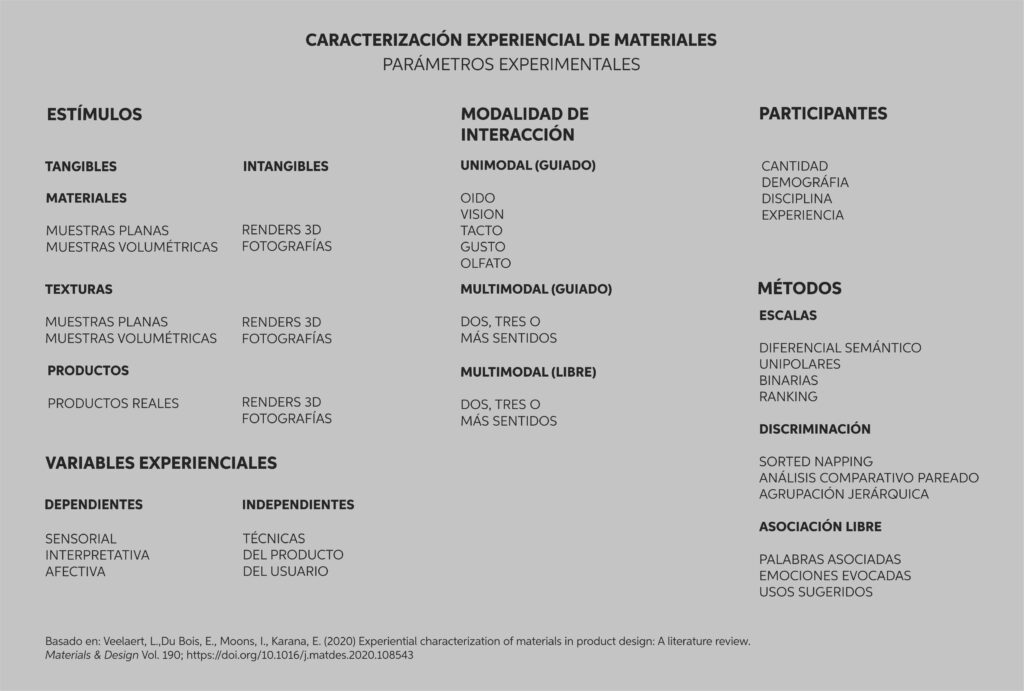
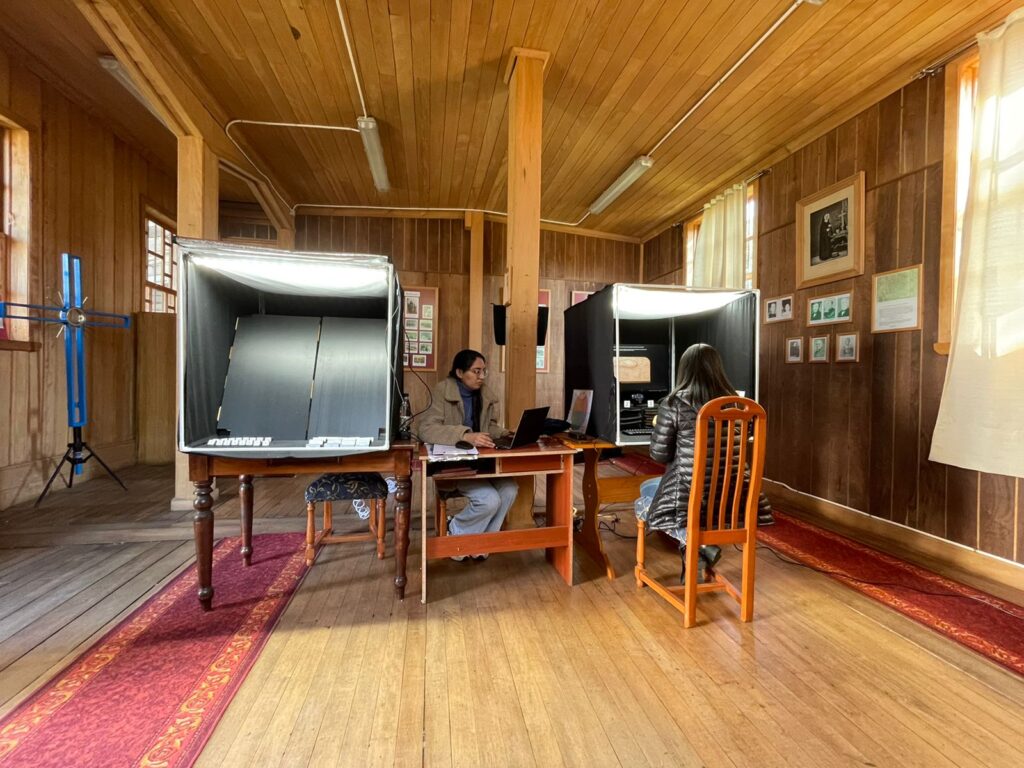

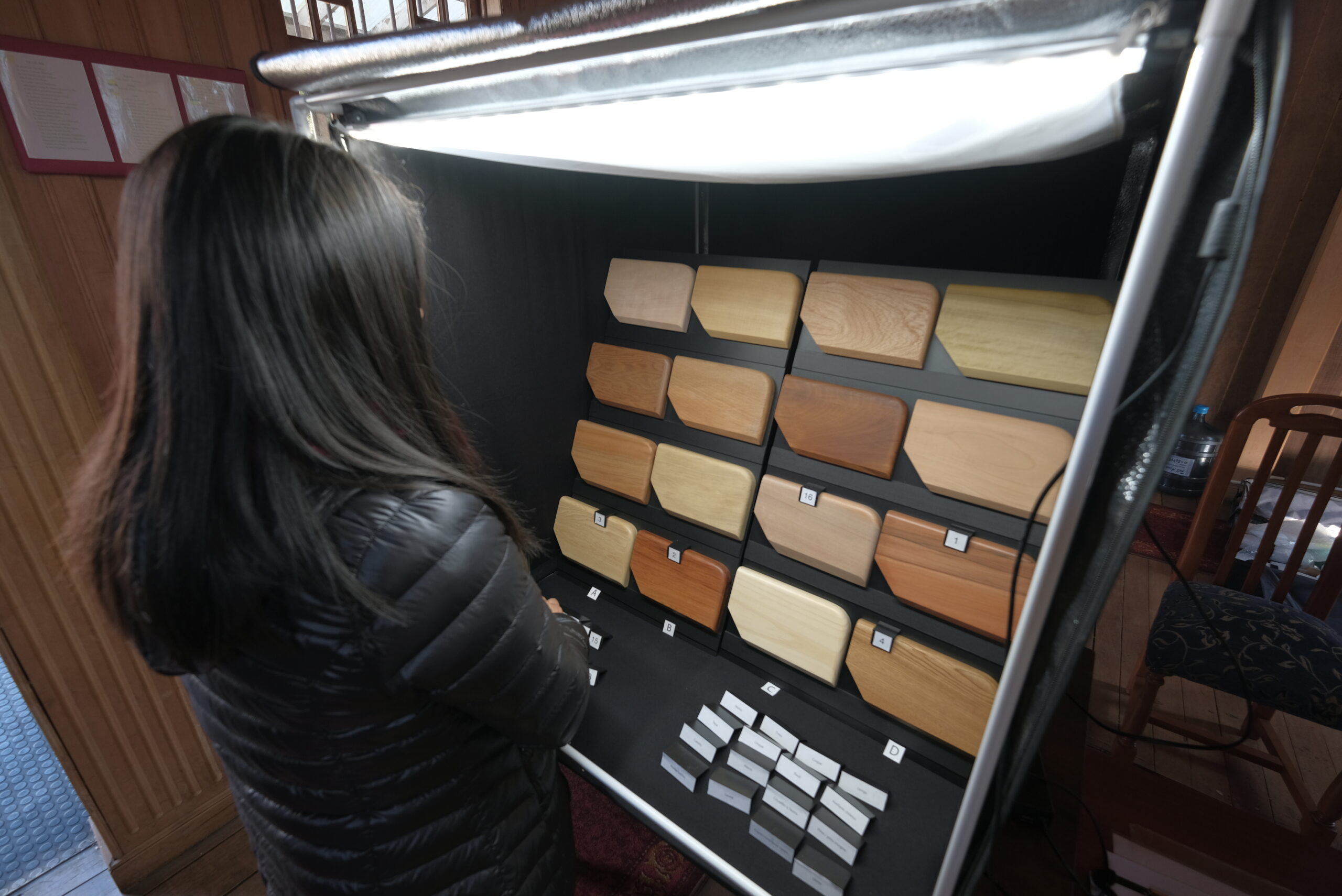

This type of analysis has become increasingly important in the world of Design, and for example the largest material libraries such as Material ConneXion, MaterialDistrict or MaterFAD, or influential sites such as the blog Hello Materials have already incorporated to some extent to their material files and articles this type of features.
The existence of specific methods in this area, such as MDD (material driven design) (Karana et al., 2015) and specialized tools to perform evaluations of this type such as the toolkit proposed by Camere & Karana, (2018) have proved to be valuable contributions in the search for a multidimensional characterization of materials: on the one hand that of the physical-mechanical or “technical” type and on the other the experiential type (as the same authors call it), which integrates aspects linked to emotions, perception, culture and sensory interaction among others.
The recent concept of “expressive qualities of materials”, which will be used in the framework of this project, addresses the emotional, semantic, affective and sensory dimensions of the materials that make up the products. Beyond their practical utility, economic value or physical-mechanical characteristics, materials are loaded with meanings, representing and transmitting the messages that designers express in the products they develop.
There is currently sufficient academic evidence (Ayala-Garcia & Rognoli, 2017; Karana, 2016; Karana, Barati, Rognoli, & Van Der Laan, 2015; Karana, Hekkert, & Kandachar, 2010; Karana, Pedgley, & Rognoli, 2014) to support the certain possibility of establishing the experiential characteristics of a material especially notable in this aspect such as wood and with some independence of the products to which it can be subsequently applied. The Material Driven Design (MDD) approach proposes that these characteristics, in the same way as hardness or resistance, correspond to relevant information that designers evaluate to make design decisions in their creative processes.
Wood is not alien to the aforementioned considerations, beyond its hardness, weight, strength, flexibility, it has certain grain patterns, different colors and tones, it is perceived as warmer and closer than other materials, it is associated with craftsmanship, it has tradition and ages well, wooden objects gain value the longer they exist because it is a material that has personality (Ashby & Johnson, 2003; Karana & Hekkert, 2010; Karana et al., 2013). Wood is attributed a certain condition of nobility, elegance and seriousness that other materials do not possess, however, not all woods are valued in the same way, and therefore, a characterization process is necessary to define more precisely the attributes from which these perceptions arise, and a valuation process to understand the levels and intensities of the various readings that users have of the material and the reasons for these differences. More specifically, it is worth asking what is the perceptual and emotional valuation of the different wood species used in the manufacture of products, and how product and material enhance and affect each other (Bumgardner & Bowe, 2002).
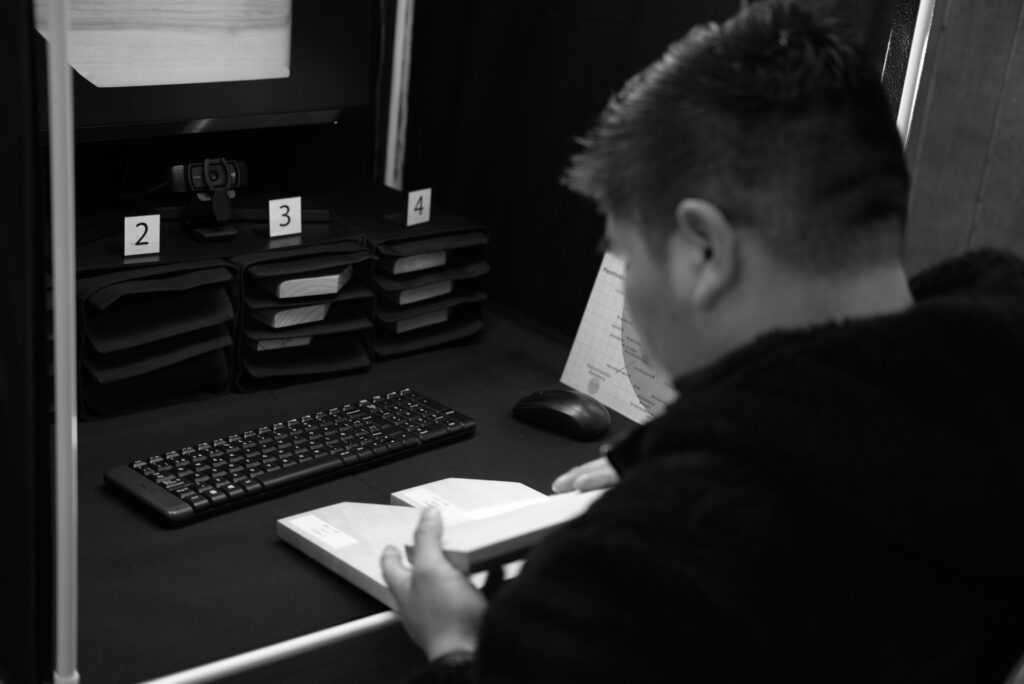
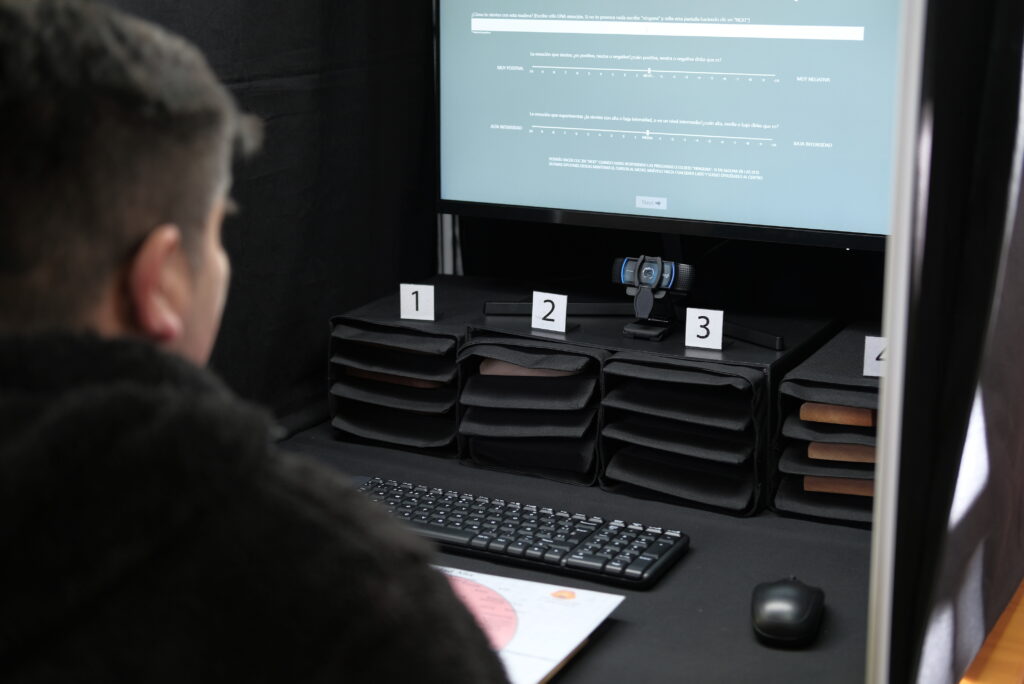



Studies conducted in other countries on these characteristics (Nicholls, Donovan, & Roos, 2004; Nicholls & Roos, 2006; Roos, Donovan, & Nicholls, 2005) evaluated, for example, US consumer preferences for kitchen furniture made from American Red Alder, the species most frequently used for this purpose, and compared it with four other species (Red Oak, Cherry, Hard Walnut and Maple).
This type of studies have suggested that the public has a certain knowledge of the wood species used in the manufacture of products, but that this knowledge is not usually very precise, on the other hand, they have established that very often the name of certain species is associated with characteristics that positively predispose their valuation.
In studies conducted with a different emphasis, Bowe & Bumgardner (2003) found that in evaluations based on physical samples, participants tended to rate woods based on overall coloration: darker woods tended to be evaluated as more expensive and elegant while lighter colored species generally tended to be seen as cheaper. Similarly, a relationship between positive descriptors and wood color has been found when the yellow or red value of the spectrum is increased (Masuda & Yamamoto, 1988).
In order to initiate a process of characterization of native woods that defines these aspects in the Chilean context, it should also be considered that the evidence establishes that this context cannot be separated from the user’s experience. In countries with a timber tradition, with large extensions of forests and policies of replanting and responsible exploitation such as Scandinavian countries, wood is considered a cheap material compared to others, and its perceived value decreases in the common public (Ljungberg & Edwards, 2003; Toivonen, 2011) compared to materials such as stone and concrete, however, in more Mediterranean areas wood begins to vary its perception and can be considered luxurious as a building material.
In relatively recent studies (Ito, Nakamura, & Masuda, 2006; Masuda, 1992) it was postulated that the natural variability of wood in terms of color, grain, surface knotiness, etc. induces different psychological feelings in individuals, and this is particularly different between cultures, for example, in Japan knots are seen as defects and people associate them with cheap wood. In general people in Japan prefer smooth wood and associate it with descriptors such as “purity”. On the contrary, in Europe and North America wood products containing knots have a large market and are associated with the words “natural” and “rustic”. Still, there is a limit, and there is a universal preference for a certain visual homogeneity of wood surfaces (Høibø & Nyrud, 2010).
The level of Scandinavian products exceeds all quality standards, generating a knowledge base in these countries adding value from Design. A key component of this knowledge base has been the emotional and sensory value of the material, its meanings, and the subsequent development of products based on the perception that people have about them (Jonsson, Lindberg, Roos, Hugosson, & Lindström, 2008; Mynttinen, 2009) knowing in depth the specific preferences of people about colors, textures, types of wood and their finishes, etc. (Bingen Sande & Nyrud, 2008; Broman, 2000, 2001). These experiences have been replicated in the USA and Canada (Bowe & Bumgardner, 2003; Bumgardner & Bowe, 2001; Rice, Kozak, Meitner, & Cohen, 2006), also large producers and processors of wood, and refocused on native species. It is therefore possible that with an adequate identification of the specific differentiating factors it may be possible to achieve positive results in our country gradually, considering the differences in idiosyncrasy and context.
The Chilean native forest has several endemic species that make it unique in the world, it also has native species with their own characteristics, some of these species are: Alerce, Araucaria (currently prohibited its exploitation), Avellano, Canelo, Ciprés de las Guaitecas, Ciprés de la Cordillera , Coigüe, Espino, Laurel, Litre, Lenga, Lingue, Mañío, Olivillo, Petra, Radal, Raulí, Roble, Tamarugo, Tepa, Tineo, Ulmo.
In the north of the country, the flora is characterized by being mostly made up of “xerophytic formations”, in the central-southern zone and especially from the Maule region, with its peak in the Araucanía and Los Lagos regions, the so-called native forest begins to spread (Bosque nativo, 2015; CONAF, 2013a). This forest as of 2013 possessed a total of more than 13,500,000 hectares considering all species, representing 82% of the total national forest land (versus 17% corresponding to forest plantations with commercial use that according to the latest figures available from the Forestry Institute, as of 2013 Chilean forest plantations covered a total area of 2. 447,591 hectares, of which 60% corresponds to the Pinus radiata species, followed by Eucalyptus globulus with 23% and Eucalyptus nitens with 10.1% (Anuario Forestal 2015, 2015)). In order to promote its sustainable use, Law No. 20,283 on Native Forest Recovery and Forestry Promotion was enacted in 2008, with the objective of protecting, recovering and improving this forest, thus ensuring forest sustainability (CONAF, 2013b).





The most common use of introduced timber species used commercially in Chile corresponds to wood for construction and products of low aesthetic value such as posts, logs or even pulp or chips, on the other hand, the use of native woods, especially Lenga, Pellín and Coigüe, the majority of national production, since the law enacted in 2008 has begun to focus on interior cladding pieces, furniture and other products that take better advantage of the expressive and emotional qualities of these species by allowing direct contact with the human senses.
Even considering the above and despite the existence of several studies that characterize and evaluate the physical-mechanical properties (Anuario Forestal 2015, 2015; CORMA, 2007; Karsulovic C., Gaete M., & León G., 2000), the definition and assessment of this type of aspects are practically nonexistent in Latin America and Chile, being the closest initiative to the subject the assessment of new possibilities (carried out through Kansei or affective engineering and the Semantic Differential tool) of coatings for boards based on radiata pine wood carried out in Chile, at the Universidad del Bío Bío by Alarcón & Di Bartolo (2013) and Briede W. & Alarcón (2012). Another tangential approach to the subject is the previous study conducted by Karsulovic C., Gaete M., & León G., (2000) on native woods as a material for the construction of musical instruments, where sensory properties related to sound and hearing are valued and a selection of species is established based on their availability in the market.
For Chile then, where the native forest is so rich in species and where almost half of the territory has such species, the potential that this represents for a discipline such as Design is enormous. Therefore, a greater knowledge of these barely explored attributes, while closely linked to the meaning, territory and natural heritage of the country emerges as a clear way to contribute, from Design, to generate this relationship of interaction between people, objects, materials and context, while positioning the discipline of Design as a key part of the processes of object development.
Ashby, M. F. (2004). Materials and Product Design. Cambridge, UK.
Ashby, M. F., & Johnson, K. (2003). The art of materials selection. Materials Today, (December), 24-35.
Ashby, M. F., & Johnson, K. (2014). Materials and Design. The Art and Science of material Selection in Product Design (3.a ed.). Oxford, U.K.: Butterworth-Heinemann (Elsevier).
Blomgren JR, G. W., & Blomgren, G. W. (1965). The psychological image of wood. Forest Products Journal, 15(4), 149-151.
Bowe, S. A., & Bumgardner, M. S. (2003). Consumer perceptions and knowledge of common furniture woods. En D. A. Yaussy, D. M. Hix, R. P. Long, & P. C. Goebel (Eds.), 14th Central Hardwood Forest Conference Proceedings (pp. 404-410). Wooster, OH, USA: Northeastern Research Station.
Broman, N. O. (2000). Means to measure the aesthetic properties of wood (Tesis Doctoral). Lulea University of Technology, Lulea, Suecia, Suecia.
Broman, N. O. (2001). Aesthetic properties in knotty wood surfaces and their connection with people’s preferences. Journal of Wood Science, 47(3), 192-198. https://doi.org/10.1007/BF01171221
Bumgardner, M. S., & Bowe, S. A. (2002). Species selection in secondary wood products: Implications for product design and promotion. Wood and Fiber Science, 34(3), 408-418.
Fenko, A. (2010). Sensory Dominance in Product Experience. (Ph.D. dissertation). Delft University of Technology, Delft, Holanda.
Fenko, A., Schifferstein, H. N. J., & Hekkert, P. (2008). Factors contributing to product experience : The cases of ‘warmth’ and ‘freshness’. En 6th International Conference on Design & Emotion. Hong Kong.
Forlizzi, J. (1997). Designing for experience: An approach to human-centered design. Unpublished Master of Design in Interaction Design …, 1-42. Tesis de Máster.
Forlizzi, J., & Battarbee, K. (2004). Understanding experience in interactive systems. En on Designing interactive systems: (Vol. 37, pp. 261-269). https://doi.org/10.1145/1013115.1013152
Hassenzahl, M. (2010). Experience Design: Technology for All the Right Reasons. Synthesis Lectures on Human-Centered Informatics (Vol. 3). https://doi.org/10.2200/S00261ED1V01Y201003HCI008
Høibø, O., & Nyrud, A. Q. (2010). Consumer perception of wood surfaces: The relationship between stated preferences and visual homogeneity. Journal of Wood Science, 56(4), 276-283. https://doi.org/10.1007/s10086-009-1104-7
Jacob-Dazarola, R., Venegas-Marcel, M., & Donoso-Cisternas, S. (2019). Hacia una caracterización experiencial de la madera como material para el diseño de productos. Legado De Arquitectura Y Diseño, 14(25), 62-71. doi:10.36677/legado.v14i25.12033
Jonsson, O., Lindberg, S., Roos, A., Hugosson, M., & Lindström, M. (2008). Consumer Perceptions and Preferences on Solid Wood, Wood-Based Panels, and Composites: A Repertory Grid Study. Wood and Fiber Science, 40(4), 663-678.
Jordan, P. W. (2000). Designing Pleasurable Products. An Introduction to the New Human Factors (1.a ed.). Londres, UK, UK: Taylor & Francis. https://doi.org/citeulike-article-id:381870
Karana, E., & Hekkert, P. (2008). Attributing meanings to materials. 6th International Conference on Design & Emotion, (1), 1-18.
Karana, E., & Hekkert, P. (2010). User-Material-Product interrelationships in attributing meanings. International Journal of Design, 4(3), 43-52.
Karana, E., Hekkert, P., & Kandachar, P. (2009). Meanings of materials through sensorial properties and manufacturing processes. Materials and Design, 30(7), 2778-2784. https://doi.org/10.1016/j.matdes.2008.09.028
Karana, E., Pedgley, O., & Rognoli, V. (Eds.). (2013). Materials Experience. Fundamentals of materials and Design (1.a ed.). Butterworth Heinemann.
Karana, E., & Van Kesteren, I. (2006). Material effects: The role of materials in people’s product evaluations. 5th Design & Emotion Conference Proceedings.
Ljungberg, L. Y., & Edwards, K. L. (2003). Design, materials selection and marketing of successful products. Materials & Design, 24(7), 519-529. https://doi.org/10.1016/S0261-3069(03)00094-3
Masuda, M. (1992). Visual characteristics of wood and the psychological images. Mokuzai Gakkaishi Journal Of The Japan Wood Research Society, 38(12), 1075-1081.
Masuda, M., & Yamamoto, N. (1988). The wood ratio in interior space and the psychological images. Bulletin of the Kyoto University Forests, (62), 285-298.
Mynttinen, S. (2009). Young people’s perceptions of the wood products industry : a relational view. Tesis Doctoral, Helsinki, Finlandia, Finlandia: The Finnish Society of Forest Science.
Nicholls, D. L., & Bumgardner, M. S. (2007). Evaluating selected demographic factors related to consumer preferences for furniture from commercial and from underutilized species. Forest Products Journal, 57(12), 79-82.
Nicholls, D. L., Donovan, G. H., & Roos, J. (2004). Consumer preferences for kitchen cabinets made from red alder : A comparison to other hardwoods. Wood and Fiber Science, 36(3), 432-442.
Ortiz Nicolás, J. C., & Aurisicchio, M. (2011). A Scenario of User Experience. En International Conference on Engineering Design Proceedings ICED11 (pp. 1-12). Kobenhavn, Denmark.
Osgood, C. E. (1952). The Nature and measurement of meaning. Psychological bulletin, 49(3), 197-237. https://doi.org/10.1037/h0021468
Osgood, C. E., Suci, G., & Tannenbaum, P. (1957). The Measurement of meaning (1a). Champaign, IL, USA: University of Illinois Press.
Ostuzzi, F., Salvia, G., & Rognoli, V. (2011). The value of imperfection in industrial product. En Proceedings of DPPI 2011 (pp. 1-8). Milano, Italy: ACM Press. https://doi.org/10.1145/2347504.2347554
Prada Molina, M. (2011). Estudio comparativo de las respuestas del usuario provenientes de la evaluación perceptiva unimodal y multimodal. Integración del análisis sensorial en el proceso de diseño de productos. (Ph.D. dissertation). Universidad Politécnica de Valencia, Valencia, España.
Rice, J., Kozak, R. A., Meitner, M. J., & Cohen, D. H. (2006). Appearence wood products and psychological well-being. Wood and Fiber Science, 38(4), 644-659.
Rognoli, V., & Levi, M. (2004). Emotions in Design through Materials: An Expressive-Sensorial Atlas as a Project Tool for Design of Materials. En 4th International Conference on Design & Emotion (pp. 1-11). Ankara, Turquía.
Sande, J. B., Nyrud, A. Q., Qvale Nyrud, A., & Nyrud, A. Q. (2008). Consumer preferences for wood surfaces–a latent variable approach. Proceedings of the Biennial Meeting of the Scandinavian Society of Forest Economics, 195-215.
Schifferstein, H. N. J., & Spence, C. (2008). Multisensory Product Experience. En H. N. J. Schifferstein & P. Hekkert (Eds.), Product Experience (pp. 133-161). Amsterdam, Holanda: Elsevier. https://doi.org/10.1016/B978-008045089-6.50008-3
Toivonen, R. (2011). Dimensionality of quality from a customer perspective in the wood industry. Dissertationes Forestales (Vol. 2011). Tesis Doctoral, Helsinki, Finlandia, Finlandia: Finnish Society of Forest Science. https://doi.org/10.14214/df.114
Van Kesteren, I. (2008). Selecting materials in product design (Tesis Doctoral). Delft University of Technology. https://doi.org/978-90-5155-040-5
Van Kesteren, I. E. H., Stappers, P. J., de Bruijn, J. C. M. (2007). Materials in Products Selection: Tools for including user-interaction in materials selection. International Journal of Design, 1(3), 41-55.